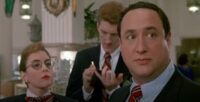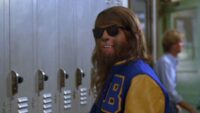Content warning for sexual assault and other sensitive subject matter.
Coming-of-Age Stories: The Clichés & The Crusaders
It’s hard to say when the tropes of onscreen bullying first emerged. Today, they dominate stories set in grade school. It is all too easy to envisage the slow-pan around a school cafeteria—the camera, situated in a geek’s POV, scanning a sea of unwelcoming faces; to anticipate the geek’s ensuing search for an elusive spot to place their lunch tray; to reimagine their locker covered in graffiti, vandalized, and booby-trapped; to picture their fretful walk home, which inevitably ends up pinned up to dumpster or bathroom wall, surrounded by hecklers; to conceptualize the proverbial class clown slumped in the back row shooting spitballs and causing a ruckus, or the school-jock/queen-bee strutting down the school hallway gleaming mischievously and flanked by their dragooning cavalry.
Suffice to say, when it comes to teen/pre-teen shows and movies, we have been oversaturated with clichés. Somewhere along the way, the familiar signifiers surrounding (pre)adolescent rejection, hierarchical school systems, and lunchtime pecking orders became domineering motifs. They permeated our stories and refused to go away. Like an invasive species or an Internet meme, these clichés endlessly replicated with little variation. Mutating lazily and artificially, they overtook the creative landscape. Tired, unreflective, and played out, they infested our thought processes and capacity to reminisce, commandeering sole authority over our nostalgic neural pathways.
How exactly did these visual clichés gain so much traction? It is hard to pinpoint the origin and the allure. Some storytellers were, perhaps, just pandering to easy symbolism and genre norms; others were likely just resorting to safe and digestible dramatic altercations. Whatever the case, the result is the same: lazy grade-school clichés intransigently calcified into stone, forming an alien, alternative reality that largely misses the mark.
To be fair, even these trite grade-school scenes reflect a timeless, fundamental truth: that prepubescence is a vicious popularity contest populated by predatory little devils. In the eternal pursuit to fit in, kids have always precipitated indiscreet terror attacks upon one another for external approval. From violent initiation rites to ritualistic teasing, putting one’s peers through the infamous ringer is a deeply entrenched and tribalistic habit.
A key component of our collective experience, these realities deserve—even demand—to be depicted. They do not contradict human nature. At the same time, these truths are too often compromised by formulae that strip our coming-of-age stories of their quirky, intimate, relatable details. Fortunately, the world of American independent cinema offers a refuge. Even if the club of filmmakers/films that boldly dares to tell original tales is quite small, we certainly have some pioneers, including Harmony Korine (Kids, Gummo), David Gordon Green (George Washington), Bo Burnham (Eighth Grade), Sean Baker (The Florida Project), and of course, Todd Solondz’s entire filmography.
Circumventing the sterile cinematic language of their professional peers, these auteurs reconnect us with our inner child—creating direct portals that transport us back into the uniquely deranged perspectival spaces of youth. These rogue artists exquisitely remember, with painful detail, the feelings, mood swings, and melancholy that accompany those nascent and ungainly developmental years of our lives.
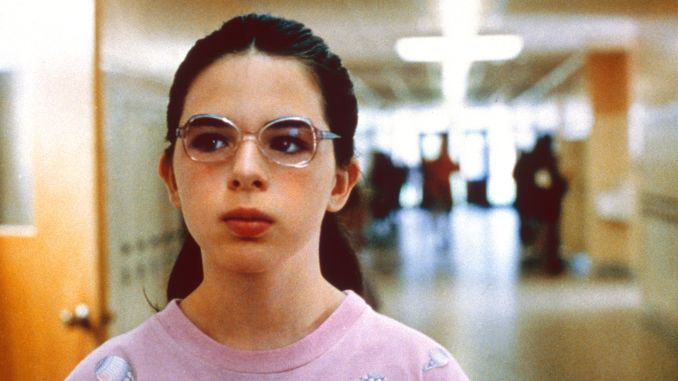
Welcome to the Dollhouse’s Deviously “Stale” Setup
When it comes to depicting the ugly underbelly of childhood, Todd Solondz is undoubtedly one of America’s chief trailblazers. An enfant terrible unafraid to venture into dangerous grounds, Solondz’s films deal with every dominant taboo: incest, pedophilia, rape, murder, etc. More interestingly, his movies filter taboos through a uniquely intimate and compassionate lens. Filling his films with uncomfortably relatable child molesters, rapists, and pedophiles, Solondz disturbs audiences not only by broaching icky subjects and topics, but also by his uncanny ability to make us sympathize with the aberrant figures.
In a relatively recent 2016 interview with Vice, Solondz put this agenda into explicit terms. Speaking about his artistic decision to not demonize pedophiles, Solondz explained: “We live in times of hysteria, and it’s reshaped the way we treat both children and adults. To me, the challenge was how could I make someone care for someone that we would all viscerally want to reject?” This is a daring maneuver that he has repeated throughout his filmography. Attracted to exploitative topics and shocking content, Solondz reminds us that weirdos, perverts, freaks, geeks, and miscreants are human—he reminds us of the pencil-thin line that separates us all.
Full disclosure: given my appreciation of Solondz’s daredevil and iconoclastic flair, I found myself initially disheartened while re-watching his second feature film, Welcome to the Dollhouse. Saturating the early scenes with commonplace clichés, we first meet Dawn Wiener (the gawky, Jewish seventh-grader at the film’s center) beset by one of the classic grade-school scenarios I already described: holding a cafeteria tray and trembling before an ocean of unfriendly gazes. My knee-jerk reaction to this introduction to Dawn was tepid, at best. She then proceeds to be picked on and belittled in the most hackneyed fashion imaginable. After she finally finds her seat in the cafeteria, she is called a “lesbo” and “ugly.” Solondz then cuts to Dawn shamefully opening her locker—“Wiener-Dog” (Dawn’s nickname & the title of Solondz’s 2016 film that reprises her character) scribbled all over it. Even the bathroom is dangerous territory as an antagonistic peer gives her a hell of a time: mandating she poop on demand.
Gross as it is, this last detail at least exhibits some peculiarity. Besides this scatological decree, the early montage of Dawn’s life at school tidily fits the insipid template of every portrait of stereotypical bullies and geeks. Dawn, and the toxic affronts she endures over the course of the first twenty minutes, are disappointingly ordinary. She is a goofy, uncomely, ugly duckling—a prototypical outcast bereft of originality. The contrived opening act is certainly a poor showcase of Solondz’s maverick tendencies, but as his auteurist proclivities gradually emerged, I realized the hackneyed elements in the introduction were all part of the deviously intentional setup: Solondz was slyly mimicking banalities, piling on clichés, and pandering to genre conventions on purpose. He was rehashing the dead features of the genre so that when his narrative veered off course, the stark contrast would be more pronounced.
With methodical patience, Welcome to the Dollhouse slowly delves ever deeper into Dawn’s deeply convoluted psyche. Sardonic humor and pitch-black comedic undertones gradually overtake the once cozy/recognizable archetypes. All our impressions and expectations are eventually usurped, and by the halfway point, Solondz completely flips the script. Instead of following a run-of-the-mill story about an ugly duckling discovering a) her inner beauty, b) her confidence, or c) a handsome swain, Solondz’s hounded pariah ends up aimless, alienated, disparaged, and debased in dumpy ravines—both figuratively and literally. Dawn is not transformed into a princess, she does not become a beacon of hope, nor is she falsely tragic. Instead, she bumbles and fumbles about, experiencing the morbidly atheistic everyday reality of your average American upbringing.
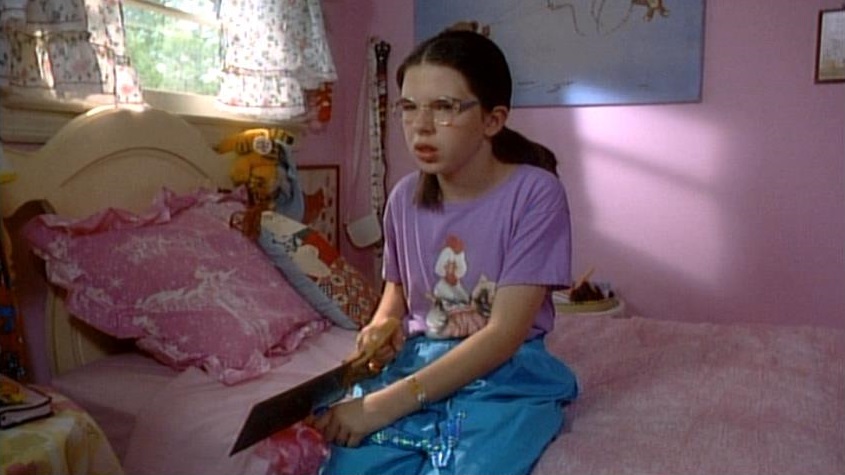
The Not-So Wonder Years
Given Solondz’s primary inspiration for the film, this dark and nihilistic vision of American youth, makes perfect sense. Citing The Wonder Years as a chief influence, Solondz is on record stating that the once-popular feel-good sitcom left him disaffected: “I had been told it was a popular show [so] I tuned in, and even though it’s set in a time when I grew up, it [bore] little resemblance to the era I knew so I wrote this script.” Spawned as an antithesis to The Wonder Years, Welcome to the Dollhouse’s acerbic take on the middle school experience is hell-bent on upheaving the classical coming-of-age story. Offering little to uplift or enlighten, Solondz’s stoic approach is bereft of moral lessons, personal growth, and fairy tale ornamentation. From a morally neutral stance, Solondz’s disturbing worldview is unforgivingly committed to a grotesque indifference: Welcome to the Dollhouse is not a fabricated fable or pathos-laden sitcom. Scene after scene, Dawn and company endure unheroic indignities with deadpan impartiality.
Dawn’s chief tormentor—a weaselly, lanky jerk named Brandon—is, like Dawn, introduced through clichés. He is first seen choking Dawn’s milquetoast friend and calling him “a fa****.” The next time we see Brandon, he has a knife to Dawn’s throat, threatening to rape her and demanding she strip. Fortunately, a school janitor walks by. When Brandon loosens his grip, Dawn runs away. Given these vile sequences, our first impression of Brandon is utter disgust. He is a caricature of middle-school villainy. However, Solondz slowly reveals unexpected layers beneath his tough-guy facade. Like Dawn, he starts off as a familiar archetype but quickly detours into unfamiliar territory.
The night of Brandon’s thwarted “rape” attempt, he calls Dawn at home and asks her why she ran off when the custodian showed up. She states she was “in a rush.” Brandon orders her to show up again so he can finish what he started—“Tomorrow, same time, same place. Be there!” Dawn, here, begins to dramatically subvert our expectations. After the phone call, her mom asks her who called and if Brandon is a nice boy. “He’s okay,” Dawn replies. This understatement is hilarious and revealing; as wild as it sounds, we realize Dawn is not entirely lying. She is kind of into him. Thus, it is not so surprising when she sovereignly shows up at the meeting spot the next day. Almost instantly, Brandon again puts a knife to her throat and leads her off-campus toward a trashy junkyard/ravine. But there is a strangely nervous, twisted sweetness underlying this journey. Odd as it sounds, Dawn seems a bit eager and excited. Does she know what “rape” even means? Does Brandon? For both parties, the entire arrangement seems nebulously understood at best.
When they arrive at a trash heap, Dawn finds a discarded mattress and asks Brandon if he wants her to lay down. He approves, asking her if she wants to smoke first. Dawn declines but off-handedly remarks that she “thinks marijuana should be legalized.” Randomly, Brandon retorts with a total non sequitur, asking why she “always has to be such a c***?” He then quickly switches subjects again, revealing he has a brother with intellectual disabilities. Dawn sympathizes with him, but Brandon rejects her pity: “You don’t have to be sorry, he’s a tough kid.” Suddenly, Brandon leans in and kisses Dawn, and she asks if he is still going to rape her. Brandon asks the time and claims there’s not enough. He then decrees, “This didn’t happen,” and warns Dawn not to tell anybody, “Or I will rape you next time.”
I recapitulated this ethically tricky scene in meticulous detail on purpose. It is perhaps the film’s most loaded, perverse, and dynamic segment. It is also emblematic of the cringe-inducing brilliance of Todd Solondz. Intuitively, by small gestures and comments, Solondz conveys that Dawn and Brandon are merely superficial enemies—deep down, they are covertly attracted to each other. Why else would Dawn autonomously consent to and then proactively remind Brandon of the so-called “rape” so many times? Clearly, the depraved theme of the date is really a ruse: a way to avoid acknowledging mutual sexual interest. By insinuating a coerced element at play, “rape” offers a pretense that loosens Dawn and Brandon’s inhibitions. It lets them act out their desires without explicitly or openly admitting mutual romantic interest. To be forthright could be social suicide. At school, Dawn is too dorky for Brandon; inversely, Brandon is too pernicious and dirty for Dawn. However, outside the realm of mores and external opinions, they genuinely like one another and use complex role-playing to navigate this cognitive dissonance.
Suffice to say, we begin to realize their tensions and hostilities at school are really sublimation: their way of releasing sexual frustration. Once freed from the gaze and perceptions of their peers, they become emotionally vulnerable and transparent. They kiss and expose intimate details in open conversation. Sure, their shared adolescent desire to sexually experiment is palpable. Nevertheless, this interest feels secondary to their desire for a friend, a confidant. Although they exist on opposite ends of the spectrum—as geek and bully—they are equals: two conflicted, horny, malcontent pre-teens desperately seeking connection without the emotional sophistication or grace to convey desire fluently.

Brandon and Dawn’s Dualistic Personalities
Unlike the conventional bully in most high school movies, Brandon is fleshed out with a backstory that offers his repulsive actions unusual and welcoming depth. We become acquainted with his insecurities and traumas. He is humanized by the fact that he comes from a tumultuous, dysfunctional household: living in a pigsty with her brother, and a boorish and domineering father. We see his disorderly domestic life near the end of the film when Dawn checks in on Brandon after he’s suspended from school. Wearing a stained, greasy tank-top, Brandon’s dad lets her in. Upstairs, she watches Brandon busily packing a rucksack to run away. He invites Dawn to tag along, but she says no. Her life is too sheltered. At least that’s what we assume—however, this will be disproved just a few scenes later.
Brandon’s home is the opposite of Dawn’s. Dawn lives in a traditional suburban household that screams normalcy. Throughout the film, Dawn’s family participates in joint activities. They eat dinner together, share cake, write anniversary songs, throw backyard parties, and cozy up on the couch to watch home videos. And yet, Dawn exists on the fringe. It is telling that in the opening title shot of the Wieners—the camera slowly zooming in on their family photo hung on a wall—we ultimately fixate on Dawn’s isolated face: her immature features, graceless grin, and despairing eyes visible and exaggerated.
Environmental differences aside, Dawn’s querulous and angsty energy closely mirrors Brandon’s. She stubbornly refuses to do chores or apologize to her sister Missy. She throws tantrums, berates her dorky brother Mark, and apes the cruel insults of her classmates. Irritable, sulky, and snappish, Dawn perpetuates the cycle of abuse, and in doing so, she becomes realistically depicted as a messy pre-teen girl. She is not a persecuted dork or a maligned saint, and we respect her even more for her roundedness.
Dawn is not simply a petulant and entitled child of privilege either. Even within her nurturing household, we witness a contentious hierarchical structure. We empathize with her sense of inferiority: she is constantly overshadowed by her prettier, angelic little sister. We feel the pangs of her fanatical infatuation and subsequent anguish over Steve (the hunky lead singer of Mark’s garage band). We root for her stubborn defiance of her mom—admiring her fortitude as she refuses to say sorry even when her slice of chocolate cake is punitively redistributed to her siblings or when she poutingly perseveres through a prolonged timeout. Dawn is truly a tour de force. Fighting against rival siblings, sadistic parenting, and violent bullies, the plight of her day-to-day life forces us to wince and revisit our own painfully clumsy childhoods.
Subject to the pratfalls of preadolescence, Dawn is also beset by a gauntlet of untoward desires and degradations. Somewhat shy and yet simultaneously brazen, Dawn flirts with Steve, oblivious of his disinterest and heedless of their age discrepancy. Dawn’s adoration of Steve encapsulates the horrid throes of pre-teen idealization: the way that idol/sexual worship can function as a surrogate outlet for exploring sexuality. Fawning, gushing, ingratiating, and imagining herself as a compatible companion, Dawn is laughably smitten.
Yet, Solondz does not sneer, mock, or belittle Dawn. We admire her futile obsession with Steve. We vicariously enter her starry-eyed state of mind. We ardently remember our own secret/forbidden crushes and absurdly impractical fantasies—how raw and powerful they were. Sure, Dawn’s affection for Steve is overzealous, unrealistic, and confabulatory, but as a visceral muse, he engenders hormonal potency: spurring Dawn to invent amorous chimeras and exercise the erotic kinks of her fledgling fancies.
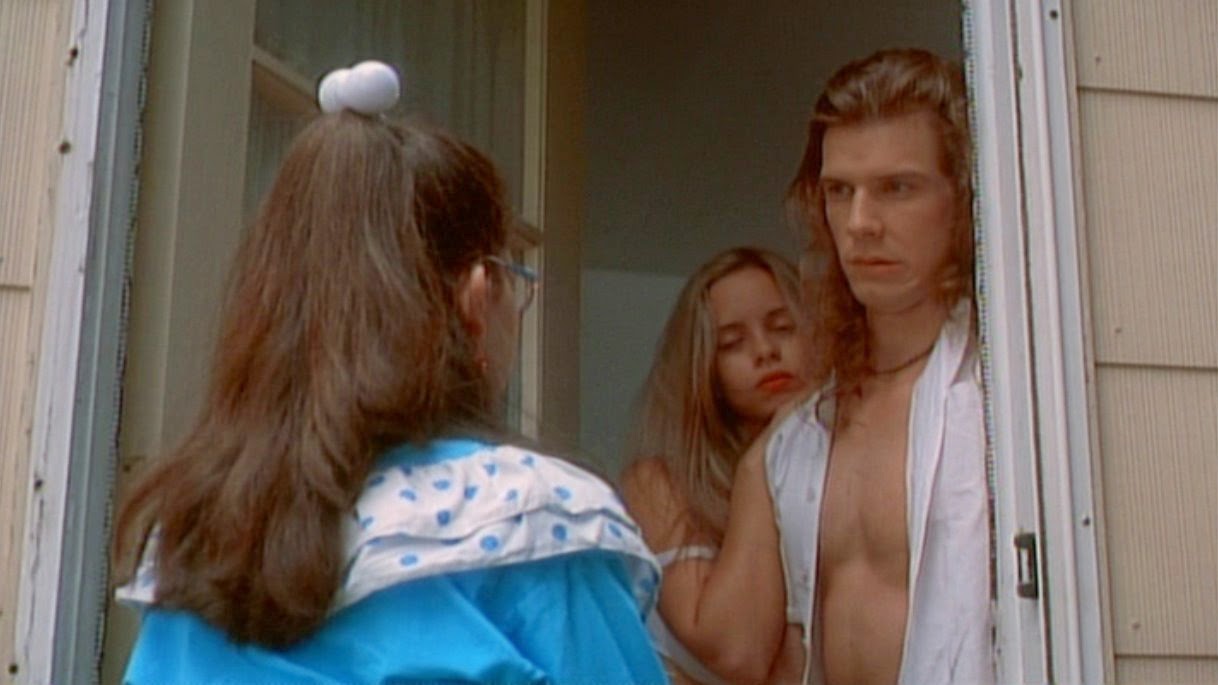
Suburban Cacophony: A Setting of False Equilibrium
One of the most tongue-in-cheek moments in the film involves Dawn sitting on the hood of her family car parked in the driveway, singing every word of “Welcome to the Dollhouse” along with Steve. We infer that Steve, the frontman of Mark’s band The Quadratics, wrote the song. And it is not hard to realize why Dawn thinks the lyrics (“I’ve got a blow-up doll / She looks like you / A little girl / The two of us have made a special world / Little girl”) speak directly to her. This scene is disturbingly poignant as well. Lip-synching and swaying side-to-side in a paisley blue dress, Dawn is noticeably trying to masquerade as a more mature woman: testing out how to best market and manufacture a cooler identity for herself.
Along with The Quadratics performances punctuated throughout the film, Solondz consistently attacks the audience with a kinetic, bellicose, percussive score. Each time Dawn gets riled up, drums and guitar blast away. The distortion and dissonance nicely echo her raucous lustful impulses and stifled hankerings. Through music, we also sense a foreboding, frenetic energy lurking within suburbia: the disorder, chaos, and bedlam seething beneath society’s plasticized, commercially packaged veneer.
Dark forces lurk everywhere in Solondz’s suburban landscapes. Consequently, it is not surprising that no one seems very shocked when Dawn’s sister Missy is abducted. The only person who seems to lose it is Mr. Wiener, who suffers from a nervous breakdown. Dawn must bring him breakfast in bed, where he lays moping under the covers—a weepy, pathetic, emotional wreck. Is Solondz deconstructing the myth of masculinity? Is he taking a stab at the patriarchy? Whatever the case, the father figure ironically fails to perform his traditional responsibility as the protector.
Meanwhile, Dawn bravely runs off to New York City to search for Missy. Does she feel remorse for having constantly denigrated her sister? Does she feel guilty for subconsciously wishing Missy was dead? Or is her noble search a smokescreen to go searching for Brandon? Dawn’s exact motives remain unclear; however, we do get a telltale dream sequence where she saves Missy and returns home to glory. In a revealing montage, Dawn’s parents, friends, teachers, and classmates all shower her with adulation: “I love you Dawn!” they exalt. The implications are startling: at least subconsciously, Dawn is more concerned about receiving praise than rescuing her sister. Like all kids, she is inherently, staunchly, and irrevocably selfish.
No such heroism manifests. It turns out that Missy returns home safe. She had been kidnapped by Mr. Kasdan, a nondescript neighbor we never met. Was Mr. Kasdan a child molester? Fortunately, it seems not: We learn that he “never touched” Missy. However, he did force her to perform pirouettes in ballet slippers. An ostensible fetishist, we are left perplexed by his motives and sexual proclivities. He is yet another one of Solondz’s salacious eccentrics—lewd yet enigmatic.
As Calum Baker so astutely points out on One Room With A View, “Solondz seems to argue—or at least wryly suggest—that Mr. Kasdan’s unsavory imprisonment of Missy is simply a grimly logical extension of the collective thought process that privileges her for her ‘cuteness’ in the first place.” This is an intriguing take. Mr. Kasdan may have transgressed in terms of legality and taboo, but his adoration of Missy in many ways mimics the way society funnels our winsome darlings through institutional pageantries. The sexist/misogynistic binary Solondz establishes here is simple: the ugly (Dawn) get trampled; the pretty (Missy) get awed and covetously ogled. Either way, the Other objectifies young women: with smears or endearment.

The Subtext of Welcome To The Dollhouse’s Slurs
Another vital thread in the film is its language. Solondz is on the record stating that his preferred title was “Fa***** and R****** [because] this is the language that kids use on a daily basis.” Bo Burnham seconds this in an interview with The Playlist, stating that watching Welcome to the Dollhouse was “like seeing kids talk for the first time […] it was tonally right.” With South Park and Beavis & Butthead dominating TV, the mid ‘90s were an era where cursing was especially trendy. Solondz seems to be tapping into this movement, albeit adding an extra layer of authenticity. When Dawn, Brandon, and their peers launch expletives, the swear words feel naturally inelegant and self-involved. Yes, hearing a middle-schooler say “c***” is jarring and showy. But the moments seem more journalistic than sensationalized, and that is a critical distinction.
Roger Ebert’s review of the film offers a complex take on the frequent use of “lesbo” and “fa****.” He first summarizes the opening cafeteria scene in which Dawn is called a “lesbo”—the slur blurted out by a choir of cheerleaders looming over her at the lunch table. Ebert then examines whether such invective should be construed as homophobic or not: “Do the lesbo and fa**** words indicate homophobia? Not necessarily. Kids that age are fascinated by sex and terrified by their own ignorance, so they attack others to assert self-confidence. Any difference at all, real or imaginary, makes someone a target. What qualifies as a difference? Anything you are that I am not, or that I fear becoming.”
This contextual analysis of the homophobic language in Welcome to the Dollhouse is fascinating. Today, we would not be so lenient, and for a good reason—homophobic attacks have deleterious consequences, regardless of their motivations. That said, Ebert offers an important contour to the discussion. His interest in the psychological impetuses behind the film’s slurs also reverberates Solondz’s storytelling style and thematic endgames. Instead of offering a blunt repudiation of the slurs as ignorant and bigoted (which they undoubtedly are), Ebert’s analysis goes a step further—speculating upon their pathological origins. Like Solondz, Ebert is discontent with the idea of lazily incriminating tyrants for fast moral vindication. That is why he meditates on the latent urges, the relatable foolishness, and the cravenly conformist inklings provoking such pillory. Upon reflection, Ebert gets into the pain of the oppressor—realizing that hateful insults often arise out of personal insecurity, libidinal confusion, and dread of Otherness. These are the real forces spearheading juvenile delinquency.
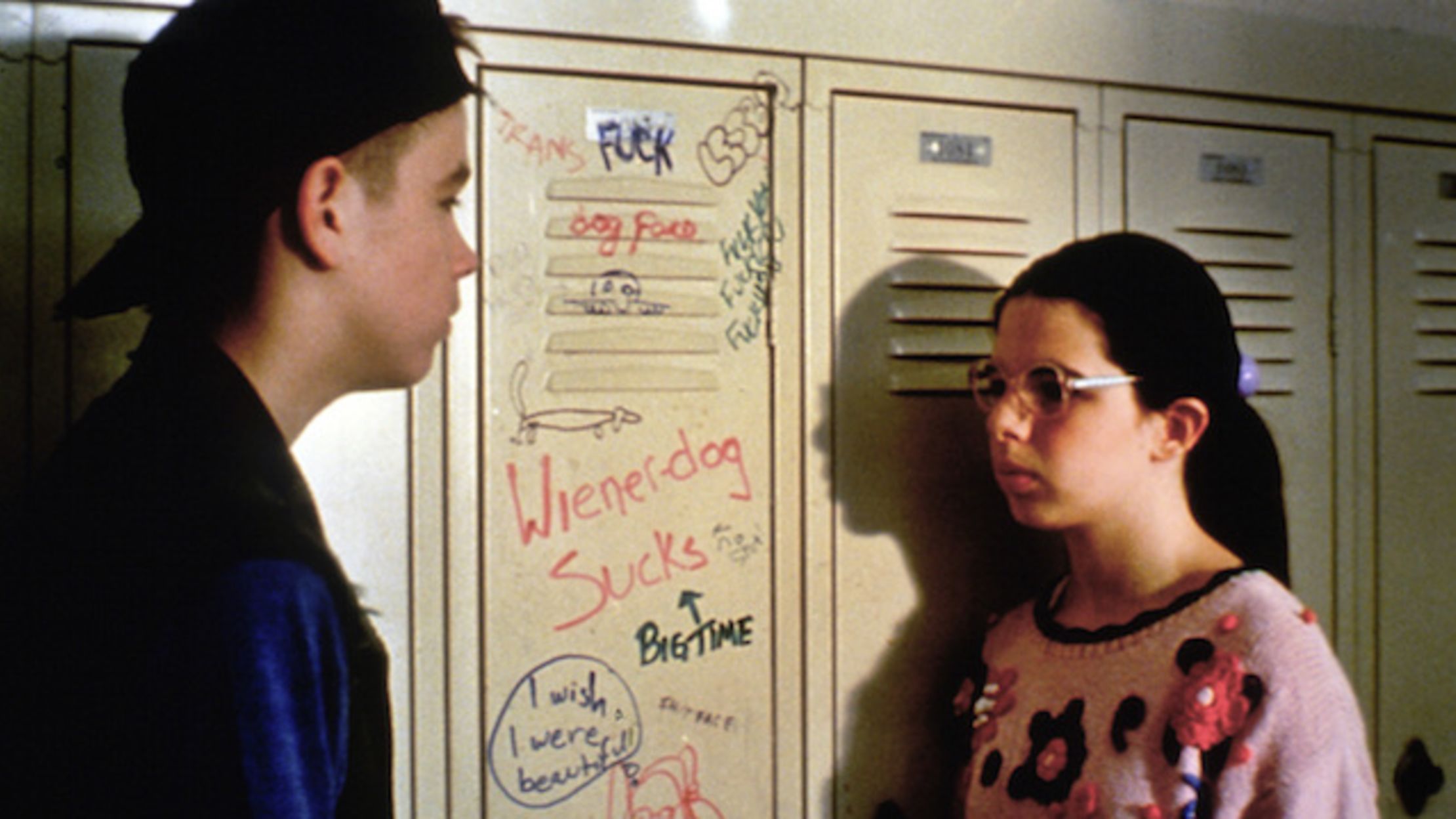
Solondz’s Transgressive & Divisive Narratives force Uncomfortable Self-Reckoning
A horrifying liminality sits at the heart of Welcome to the Dollhouse and permeates all Solondz’s movies. Few filmmakers are as attuned to the unnerving uncertainties of an unformed mind—to the conceptual or intellectual incapacity to grapple with the meaning and ramifications of wicked/noxious events. This cocktail of naivety and obscenities is precisely why childhood is so discomfiting. Solondz’s uncanny characters subsist in such spaces of unfamiliar familiarity. But why are these spaces so strange and eerie in the first place? Shouldn’t they be instantly recognizable? Perhaps they should be! The problem is most mainstream narratives have long suppressed them. Out of self-censorship or sheepishness, artists and audiences have predominantly turned a blind eye to these darker realities—inadvertently cultivating collective amnesia. Compartmentalizing grownup themes to adult movies and relegating kiddie themes to kids’ movies, we forget how complex and convoluted childhood can be.
A renegade in this respect, Solondz’s canon (which includes Palindromes, Happiness, Wiener-Dog, Dark Horse, and Life During Wartime, to name a few) is glutted with kids surviving in a world occupied by perverts, bullies, incest, jerks, pedophiles, and every type of miscreant and misfit you can think of. And what is especially unsettling is Solondz’s relentless commitment to highlighting the murky and multitudinous contradictions in these ethically dubious spaces. He is unafraid to explore transgressive behavior truthfully and earnestly—to peak beyond the platitudes of safe morality. In Solondz’s films, iniquitous actions are neither exaggerated nor diluted—abhorrent actors are neither castigated nor championed. Solondz refrains from quick judgment, and his silence speaks volumes. His silence seems to say we are our enemies: we are the warped, freaky, kinky personalities on screen.
Given the humiliating exchanges, unseemly characters, social improprieties, and offensive levity of his films, Todd Solondz is undeniably divisive. In The Playlist interview mentioned above, Bo Burnham claimed that the key difference between Solondz’s treatment of Dawn and his own depiction of Kayla (the meek female protagonist of his equally gauche and uneasy Eighth Grade) was their approach to middle-school mortification: “Todd was mean about it.” This brings up an intriguing debate that has long shadowed Solondz’s oeuvre. Critics and audiences alike cannot agree upon whether he is mocking his characters or empathizing with them. His advocates feel his supposedly unsavory outcasts are portrayed with painstaking realism and loving detail. Detractors adamantly argue that Solondz’s characters are treated condescendingly and with flat-out disgust. They sense the auteur cackling behind the camera with “morbid, calculated contempt.”
Interpreting Solondz’s relationship to his material isn’t easy. Is there a cathartic aspect to Solondz’s rabble-rousing? Is his worldview deeply misanthropic? Are his characters unfairly undignified? Does verisimilitude alone justify dabbling in unwholesome, triggering content? Does he detest the lechers in his movies? Or is he a champion for the lepers amongst us? It is hard to say. This much is clear: Unafraid of dealing with deviants, outcasts, and sociopaths partaking in degenerative behavior, Solondz is an acquired taste, but if you’re piqued by Solondz’s intellectual and moral density, Welcome to the Dollhouse is a great place to start.
Quirky and offbeat, the film is more than worthy of the Grand Jury Prize for Best Dramatic Feature it won at the 1996 Sundance Film Festival. Instead of looking back at our “wonder years” with rose-tinted glasses, it unabashedly detonates the “dollhouse” facade of suburban America. And as Solondz’s most iconic protagonist, Dawn is a great entry point for examining his polarizing filmography. Emotionally perturbed, sexually frustrated, and beleaguered by constant micro-aggressions, she crosses a constant battlefield of tricky situations. Yet, she is a total firebrand as well, refusing to be pushed over or victimized by circumstance: unwilling to submit to her condescending parents, tattle-tale siblings, and taunting/predatory peers. Thus, with excruciating veracity, Dawn provides a brutally honest glimpse into the unglamorous, hellish dichotomies of junior high. Characterized without sentimental embroidery, her underplayed blunderings mock the theatricality of most pre-teen portraitures. She is credibly besieged by stretches of loneliness, torment, and unrequited desires. Stuck in a drab cycle, Dawn’s puerile predicaments are traumatic yet quotidian, trivial yet significant. Most importantly, they are always believable.
This plausibility is paramount. Fed up with sugar-coated coming-of-age stories, Solondz wrote Welcome to the Dollhouse hoping to channel the convincing adolescent angst found in 400 Blows and Pixote. For Solondz, most American storytellers in the second of the 20th century failed at this task: “In American films, this period of life is not treated seriously. You have either the cute and cuddly Disney kid or the evil devil monster.” Sick of this hyperbolic and treacly nonsense, Solondz got to work. He sought to edify a deviant picture of America: showing its pimples, freckles, and gaffes. Snubbing the reductive representation of childhood we’ve grown so accustomed to, Welcome to the Dollhouse is a multivalent portrayal of the escapades, mischief, and tomfoolery of “growing up in the suburbs.” The film unmasks the dollhouse to poke and prod at the dark underbelly of American culture: revealing our behavioral solecisms, correctional mishaps, and endemic pathologies.

